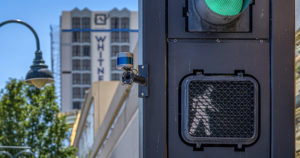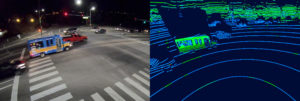
Velodyne Lidar Powers Intelligent Traffic Management
SAN JOSE, Calif., Jan. 11, 2021 — Velodyne Lidar, Inc. (Nasdaq: VLDR, VLDRW) and University of Nevada, Reno’s Nevada Center for Applied Research today published a white paper that demonstrates lidar sensors’ ability to make transportation infrastructure more efficient, sustainable and safe. The white paper reports results of research using Velodyne’s lidar sensors to improve traffic analytics, increase pedestrian safety, reduce accidents and work toward facilitated use of autonomous vehicles.

The University of Nevada, Reno’s Nevada Center for Applied Research has placed Velodyne’s lidar sensors at crossing signs and intersections to help improve traffic analytics, congestion management and pedestrian safety.
“Velodyne is excited to provide lidar technology for systems that protect pedestrians at city intersections and reduce traffic accidents. We have a synergistic relationship with the University of Nevada, Reno, which is conducting cooperative research to further the development of safety solutions at the infrastructure level using smart technology. This white paper is important to describe our collaborative work for the safety and well-being of urban communities,” stated Marta Hall, Chief Marketing Officer at Velodyne.
The white paper, called “Roadside Lidar Helping to Build Smart and Safe Transportation Infrastructure,” can be downloaded here. Also available is a video called “Smart Cities: Improving Mobility, Access and Safety with Sensor Technology,” which can be viewed here. The video looks at how lidar can be a catalyst for smart city applications that improve public services and enhance safety and quality of life.
According to the research firm Markets and Markets, the Intelligent Transportation System (ITS) market for roadways is expected to grow from USD 17.9 billion in 2020 to USD 36.5 billion by 2025, at a CAGR of 15.3 percent. This growth can be attributed to increased pedestrian safety concerns, growing traffic congestion problems and smart city developments around the world.

A Reno, Nev. intersection as viewed by a camera (left) and lidar sensor (right). The lidar provides point cloud data to measure object size, distance and movement that cameras miss.
The paper showcases research conducted by the University of Nevada, Reno’s Nevada Center for Applied Research, in conjunction with the Regional Transportation Commission of Washoe County, Regional Transportation Commission of Southern Nevada and the Nevada Department of Transportation. The project has deployed Velodyne’s Ultra Puck lidar sensors with traffic signals in real-world test environments, known as Living Laboratories, in Reno and Henderson, and sponsored by the Nevada Governor’s Office of Economic Development. It leveraged the data captured with Velodyne’s sensors to help improve traffic analytics, congestion management and pedestrian safety.
The project validated the feasibility of using roadside lidar sensors to provide high-accuracy, multimodal traffic trajectories by testing with different sensors, deployment methods and traffic scenarios. It demonstrated that roadside lidar data can support connected-and-autonomous vehicles (CAV), enhance traffic mobility and safety analysis and integrate with existing traffic infrastructure for automatic pedestrian/wildlife warning.
The project also achieved successful implementation of lidar-based automatic rectangular rapid flash beacons (RRFB), which unlike conventional RRFB, not only serves the crosswalk area but provide many additional functions. These include traffic performance data collection, jaywalk event recording and supporting infrastructure to serve CAVs and connected non-motorist roadway users.
Until recently, existing camera-based ITS traffic monitoring technologies have been widely used to study traffic flow rates, occupancy, average speed and spot speed. However, as alternative sensors come onto the market, the weaknesses of camera-based approaches become more apparent. For example, cameras have been shown to suffer in low-light conditions, are prone to optical illusions and do not allow for people’s privacy. It is anticipated that lidar will play a pivotal role in the growth of the ITS market because lidar sensors provide robust 3D data that allows for superior object detection and tracking in a wide variety of lighting and weather conditions while preserving anonymity and trust among the public.
About Velodyne Lidar
Velodyne Lidar (NASDAQ: VLDR) ushered in a new era of autonomous technology with the invention of real-time surround view lidar sensors. Velodyne is the first public pure-play lidar company and is known worldwide for its broad portfolio of breakthrough lidar technologies. Velodyne’s revolutionary sensor and software solutions provide flexibility, quality and performance to meet the needs of a wide range of industries, including autonomous vehicles, advanced driver assistance systems (ADAS), robotics, unmanned aerial vehicles (UAV), smart cities and security. Through continuous innovation, Velodyne strives to transform lives and communities by advancing safer mobility for all.
Source: Velodyne Lidar






























